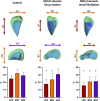The effects of mitral stenosis on right ventricular mechanics assessed by three-dimensional echocardiography
- PMID: 39048660
- PMCID: PMC11269591
- DOI: 10.1038/s41598-024-68126-y
The effects of mitral stenosis on right ventricular mechanics assessed by three-dimensional echocardiography
Abstract
Mitral stenosis (MS) is a complex valvular pathology with significant clinical burden even today. Its effect on the right heart is often overlooked, despite it playing a considerable part in the symptomatic status. We enrolled 39 mitral valve stenosis patients and 39 age- and gender-matched healthy controls. They underwent conventional, speckle-tracking and 3D echocardiographic examinations. The 3D data was analyzed using the ReVISION software to calculate RV functional parameters. In the MS group, 3D RV ejection fraction (EF) (49 ± 7% vs. 61 ± 4%; p < 0.001), global circumferential (GCS) (- 21.08 ± 5.64% vs. - 25.07 ± 4.72%; p = 0.001) and longitudinal strain (GLS) (- 16.60% ± 4.07% vs. - 23.32 ± 2.82%; p < 0.001) were reduced. When comparing RV contraction patterns between controls, MS patients in sinus rhythm and those with atrial fibrillation, radial (REF) (32.06 ± 5.33% vs. 23.62 ± 7.95% vs. 20.89 ± 6.92%; p < 0.001) and longitudinal ejection fraction (LEF) (24.85 ± 4.06%; 17.82 ± 6.16% vs. 15.91 ± 4.09%; p < 0.001) were decreased in both MS groups compared to controls; however, they were comparable between the two MS subgroups. Anteroposterior ejection fraction (AEF) (29.16 ± 4.60% vs. 30.87 ± 7.71% vs. 21.48 ± 6.15%; p < 0.001) showed no difference between controls and MS patients in sinus rhythm, while it was lower in the MS group with atrial fibrillation. Therefore, utilizing 3D echocardiography, we found distinct morphological and functional alterations of the RV in MS patients.
Keywords: Atrial fibrillation; Contraction pattern; Mitral stenosis; Right ventricle; Speckle-tracking echocardiography; Three-dimensional echocardiography.
© 2024. The Author(s).
Conflict of interest statement
AK serves as Chief Medical Officer of Argus Cognitive, Inc, and receives financial compensation for his work, outside the submitted manuscript. BKL, and AF receive modest honoraria as medical consultants of Argus Cognitive, Inc., outside the submitted work. Other authors have no competing interests.
Figures


References
MeSH terms
Grants and funding
LinkOut - more resources
Full Text Sources
Miscellaneous

